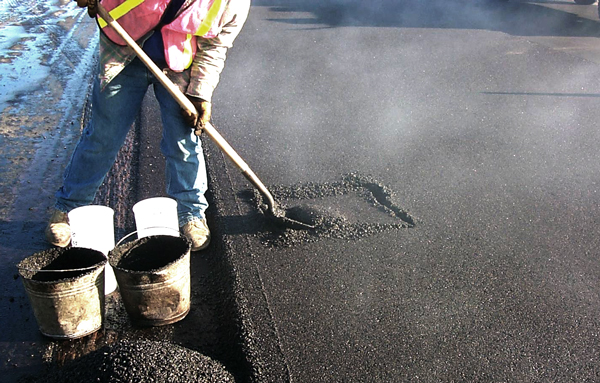Reimagine Your Room: Hot Mix Asphalt Paving for Angled Parking Lot Jobs
Reimagine Your Room: Hot Mix Asphalt Paving for Angled Parking Lot Jobs
Blog Article
Unlocking the Tricks of Warm Mix Asphalt Modern Technology
Discovering the midsts of hot mix asphalt technology reveals a world where thorough procedures and precise formulas assemble to shape our roads and framework. The fusion of binders, fillers, and aggregates isn't merely a building and construction task yet a calculated orchestration of toughness and effectiveness.
Importance of Warm Mix Asphalt
Warm Mix Asphalt plays a critical role in modern facilities development due to its resilience and cost-effectiveness. As the most generally made use of leading product for roadways, freeways, and car parking lots, Hot Mix Asphalt offers an array of benefits that contribute to its significance in building jobs.
The durability of Hot Mix Asphalt comes from its structure, that includes aggregates, binder, and filler products that are carefully chosen and mixed to meet specific performance demands. This accurate combination causes a flexible and strong sidewalk that can withstand regular use without significant damage. Warm Mix Asphalt is 100% recyclable, additional boosting its sustainability and ecological advantages. Generally, the significance of Warm Mix Asphalt in facilities advancement can not be underrated, as it remains to be a foundation of modern building and construction techniques.
Parts of Asphalt Mixes
The structure of asphalt mixes contains thoroughly picked accumulations, binder, and filler materials that are crucial for attaining specific efficiency demands. Accumulations are the primary element of asphalt blends, offering stamina and security. These accumulations can be natural, such as gravel or smashed rock, or synthetic, like recycled products from old sidewalks. The binder, typically asphalt or asphalt cement, holds the aggregates with each other and gives adaptability and resilience to the mix. The option of the binder is crucial as it directly influences the mix's performance in various weather. Fillers, such as moisturized lime or Rose city concrete, are used to enhance the mix's workability and aging resistance. Angled Parking.
The combination and proportion of these parts play a considerable function in figuring out the high quality and efficiency of the asphalt mix. Designers thoroughly create the mix to satisfy certain demands, thinking about variables like traffic volume, environment problems, and pavement life-span. Correct option and harmonizing of aggregates, binder, and fillers are necessary for creating durable, durable asphalt sidewalks.
Mixing and Manufacturing Techniques

Once the aggregates are selected, the binder, frequently asphalt cement, is contributed to bind the materials with each other. The binder's top quality and amount substantially affect the mix's adaptability, resistance, and strength to environmental elements. Additionally, fillers like moisturized lime or Portland cement might be integrated to improve specific attributes of the asphalt mix, such as its workability or wetness resistance.
During manufacturing, the accumulations and binder are heated up, typically in between 250-325 ° F(121-163 ° C ), to facilitate blending and make sure proper coating of the aggregates. The mixing process has to be complete to accomplish an uniform blend that advertises the wanted performance characteristics of the asphalt. Numerous methods, such as set mixing or drum blending, are utilized to achieve high-grade and consistent asphalt blends for building projects.
Aspects Affecting Asphalt Efficiency
Aspects influencing asphalt performance incorporate a variety of variables that influence the resilience, durability, and overall high quality of asphalt sidewalks. One essential aspect is the high quality of materials utilized in the asphalt mix. The kind and source of aggregates, the binder high quality, and the ingredients all play a significant function in determining the performance of the asphalt sidewalk. The rank of aggregates is critical as it affects the mix's workability, security, and resistance to rutting and splitting.

Style considerations, such as pavement thickness and drainage, are vital in making certain the long-term performance of the asphalt pavement. By thoroughly thinking about these engineers, professionals and factors can optimize asphalt performance and improve the service life of sidewalks.
Sustainable Practices in Asphalt Modern Technology

Furthermore, the advancement of warm-mix asphalt (WMA) technologies has actually gotten traction recently. WMA enables the manufacturing and placement of asphalt mixes at reduced temperatures compared to typical hot-mix asphalt, leading to decreased energy usage and greenhouse gas emissions. The use of porous asphalt blends can help alleviate stormwater drainage issues by enabling water to infiltrate with the sidewalk and into the ground, promoting natural water purification and charge processes. By applying these lasting techniques, the asphalt sector can contribute to constructing a much more resilient and environmentally pleasant infrastructure network.
Final Thought
In final thought, warm mix asphalt technology plays an important function in contemporary facilities advancement because of its longevity and cost-effectiveness. By carefully stabilizing components, employing proper mixing methods, and thinking about different elements, engineers can create premium asphalt blends that hold up against hefty web traffic tons and severe weather condition conditions. Embracing lasting techniques, such as using warm-mix technologies and recycled products, additionally improves the environmental kindness of asphalt modern technology.
Mixing and manufacturing methods in hot mix asphalt technology entail the accurate combination and processing of accumulations, binder, and fillers to create a resilient and high-performance asphalt mix.Factors affecting asphalt performance incorporate a variety of variables that influence the sturdiness, longevity, and general top quality of asphalt pavements. Sustainable practices in asphalt technology include different initiatives aimed at decreasing the environmental influence of asphalt production and paving processes. By including recovered asphalt sidewalk (RAP) and recycled asphalt tiles (RAS) into brand-new asphalt blends, the market can substantially minimize the consumption of raw products and power, while additionally reducing landfill waste.
WMA enables for the production and placement of asphalt mixes at reduced temperatures contrasted to standard hot-mix asphalt, resulting in minimized power usage and greenhouse gas discharges.
Report this page